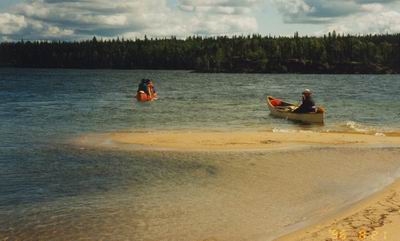
Day 4
Wednesday 08/21

Peter: We were on the water by 9.05. The wind was still blowing hard in our faces, raising whitecaps, and we sought the shelter of any islands along the way. After a hard paddle we rested for some minutes on an island at 9.45. We saw some nice beaches, and sheltered again behind the next island. Mike estimated that we had covered 51 km. so far. We stopped about noon for lunch on 'Fish Tail' Island.
Sharon:
Morning came with high winds and white caps on the lake.
Our group canoed across to the islands and paddled behind them for
shelter. I’ve been in these waves
before just as Peter, Mike, Rick, Brent, Sandy and Warren have too. Looking over to Dawnna I was wondering how she was doing; all
this was a first for her. Before
this she had only done smaller lakes and calm winding rivers.
Not into reading the map and the land, Dawnna only knew she was in the
middle of nowhere. Being happy with just that and enjoying the wilderness of the
North.
Jotting islands we find one to stop and have lunch. Feeling wind blown on the face I welcomed the sun shining and the calmness on the island. With the guys talking about the green food that they’ve eaten on other trips I was hoping this wasn’t one of them. The hot dogs planned for this day were not all that bad. In fact they looked good over the campfire and I ate my fill. Mike enjoying the meal and ate every last morsel.
Click here for a larger map
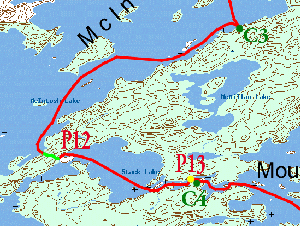 McIntosh
Lake drains into Trout Lake through a channel of fast water and rapids. According
to Canoeing the Churchill by Greg Marchildon & Sid Robinson,
North West Company traders had gone up this channel by 1790, and built a post on the
eastern shore of McIntosh Lake, which at one time was occupied by Alexander
Fraser
McIntosh
Lake drains into Trout Lake through a channel of fast water and rapids. According
to Canoeing the Churchill by Greg Marchildon & Sid Robinson,
North West Company traders had gone up this channel by 1790, and built a post on the
eastern shore of McIntosh Lake, which at one time was occupied by Alexander
Fraser
Portage P12 avoids this channel to Trout Lake and the class 3+ Trout Falls and Moose Rapids which connect Trout Lake to Stack Lake, by connecting McIntosh directly to Stack Lake.
Canoeing the Churchill mentions that there are no longer any trout in Trout Lake, and that modern Cree reserve the name Numekos Sakuhikun (meaning Trout Lake) for McIntosh Lake. However, the weather was not conducive to fishing on McIntosh.
Most of the flow of the Churchill flows down a south channel from Trout Lake to Nipew Lake, but the fur trade route was through Stack and Mountney Lake, and this was the route we took.
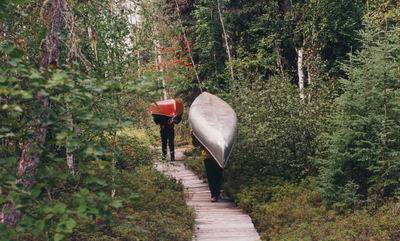
P12 is 260 metres long and in luxurious condition since the outfitter on McIntosh Lake has installed boardwalks.
Canoeing to the end of the lake, feeling chilled to the bone we do Trout
Portage. The weather has changed
for the better and I warm up quickly on the trail that also has a manmade
boardwalk. At the end of the
portage Rick greets us with “Welcome to the Churchill River.”
The guys would like to look at Trout Rapids and canoe in that
direction. There I see huge waves
so powerful and think, “What are we going to do with this?”
The guys observed the enormous rapids and called them “haystacks.”
Rick explained to me how haystacks work, but I didn’t understand it.
Thankfully they were just looking and we continued on to camp at Rock
Trout Rapids.
A further 500 metres brought us to Rock Trout Rapids, class 3, bypassed by the 260 metres long portage, P13. We decided to camp here at 4.00 pm, and unloaded the canoes.
Canoeing the Churchill says The rapids begin near the top of the south-side channel where it narrows to form a bad chute. After this initial bad chute there is less turbulent water for about 50 metes. There is then a second chute followed by a final run-out of fast water. In low water conditions the rapids may perhaps be run by experts, but ordinarily , the chutes make them too difficult for canoes. We advise all canoeists to make a full portage at Rock Trout Rapids.
But in 1996, Peter had not yet read the book and when we ran them the water was very high!
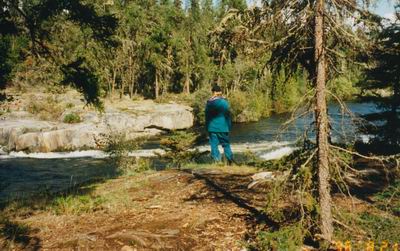
Sandy looking at the rapid from the campsite
We unloaded the canoes and made camp. We then started to run the rapids with empty canoes.
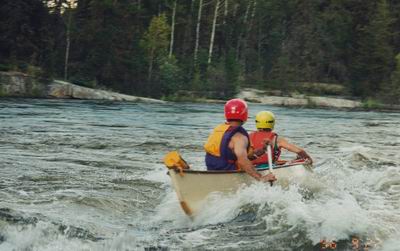
Warren and Sandy ran first, and carefully hugged the right bank, eddied out half way down and made it.
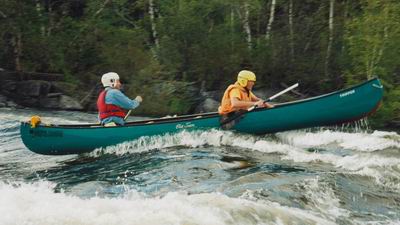
Then Mike and Peter tried. They were swept too far to the left and missed the downstream tongue.
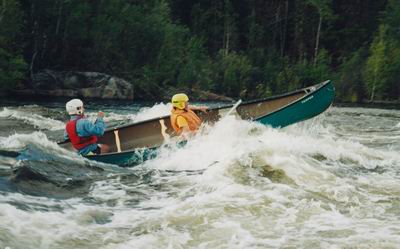
A big curling wave tipped them over (with Peter hanging on to the gunnel, a no-no).
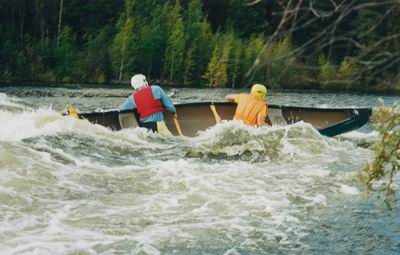
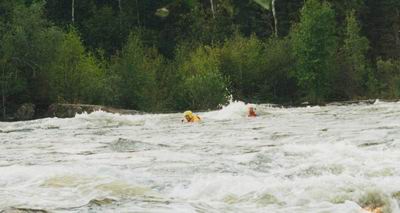
Peter survived the first dunking but then took a deep breath as he entered the second set of waves!
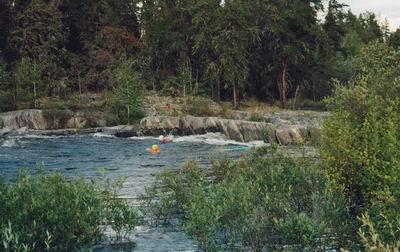
Mike swam through OK, but Peter choked and spluttered all the way down, and was incapable of answering Mike's "Are you OK?'.
Warren quickly dived in to the rescue (his mother would have been upset if he had lost his father!), but saw that Mike, an expert swimmer, was shepherding Peter, so he went and rescued the canoe.
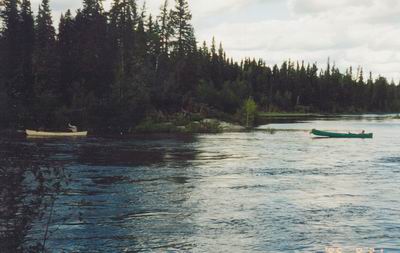
Mike and Peter emerged on the left bank, and Warren paddled across to pick them up.
Sharon saw it this way:
Setting up camp early the guys had fun running the rapids.
I have great admiration for Sandy who was the only woman to run Rock
Trout Rapids. Hearing the guys talk
about the run and powerful sound of the rapid made my stomach turn. Rick and I try our hand fishing at the end of the portage
trail. We hear a lot of commotion
up river for Mike and Peter dumped their canoe.
Brent picks up a camera and takes pictures. Warren dives into the river to rescue his dad Peter.
Peter who was wearing a lifejacket that barely kept his head above water
gasped for air. Mike is swept close to the rock ledge left and over the
rapids. He swims safely to the
shore but then notices Peter having trouble and goes back in and pulls him
towards shore. Warren sees Peter is
safe and swims for the rented canoe and oars being swept down river.
Rick and I quickly canoe to Warren and bring him to shore with the canoe
and oars. Warren canoes up river to
pick up Mike and Peter and brings them back across. They were a bit shaken, but ok.
Every rapid has it’s own story for each canoeist and there are a lot of
stories told, with awe from every listener.
That excitement ended running rapids for the day .
Before evening, we picked blueberries for they were everywhere along the portage path. Low bush cranberries also carpeted the ground in places. That night Dawnna and Brent made dough for blueberry pyrohy. I just call them “blueberry perogies.” Sandy and I sweetened and thickened the blueberries for the filling. Warren fried them with butter over the fire and they were the best treat after an exciting day of running rapids.
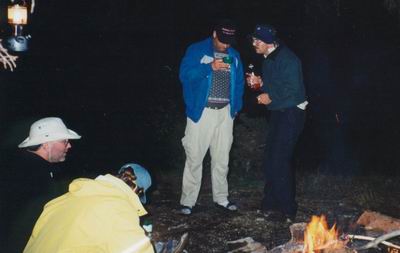
Mike and Peter were awarded an extra ration of rye that evening
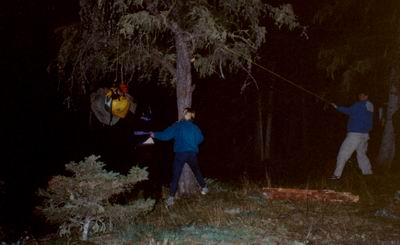
That night the guys found a tree that hung over the river and was a perfect place to hang the food bag. Sandy with one arm grabbing a tree and her other arm is holding Warren to keep him from falling into the river. While he is directing the food bag the guys are pulling the ropes in the background.